by Lisa Cooke | Sep 2, 2017 | 01 What's New, Ancestry, DNA, MyHeritage
Has it been awhile since you have perused your DNA matches? Here’s how reviewing your DNA test results regularly can help your family history.

By now, many (if not most) of the genealogists I meet at conferences have had their DNA tested. Good for you! But how often are you checking on your DNA matches? It’s easy to forget about them after that first exciting look at your match list and the flurry of emails that you received. You should be checking in regularly! Here are two great reasons why:
1. You may have new DNA matches.
 More and more people are flocking to these companies to have their own DNA tested. Why just this month, AncestryDNA announced they have tested 5 million people. It was only in January of 2017 that they announced they’d hit 3 million, so they’ve added more than two million people so far this year.
More and more people are flocking to these companies to have their own DNA tested. Why just this month, AncestryDNA announced they have tested 5 million people. It was only in January of 2017 that they announced they’d hit 3 million, so they’ve added more than two million people so far this year.
What this means is that just as new records are constantly being added online (we cover millions of new additions every Friday on this blog), so are new DNA test profiles. That means you will keep discovering new DNA matches in your list over time. That elusive cousin you’ve been hoping would test may do so tomorrow. A key relative on your dad’s side–maybe on a line with unknown parentage–may have tested three weeks ago, with results now pending. (Genealogy Gems Editor Sunny Morton told me she has had two ground-breaking DNA matches in the past two months alone. Lucky her!)
In AncestryDNA, you can actually sort to view new matches. From your AncestryDNA home page, click View all DNA matches. Then select the filter New by clicking on it.

AncestryDNA will now just show you, in order of degree of relation, any matches you haven’t yet clicked on to review more closely. This can be quite a time-saver. And it can also help remind you of any matches you may have already seen in passing but haven’t closely reviewed.
Another tip: under each of your AncestryDNA matches, you can also see how long it’s been since that person logged in, as shown here.
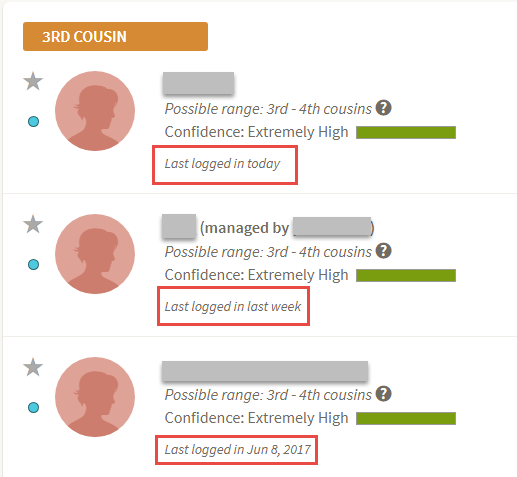
Perhaps you emailed someone a while back but never heard anything (or didn’t notice a response). If you can see that a person is actively using the site now, it may be worth reaching out again.
2. New tools to review your DNA matches may be available.
 While you’ve been busy recently tracking down census records and virtually visiting the courthouses, your DNA testing companies have been busily adding to their offerings. Just recently, MyHeritage revealed a beautiful, streamlined way to review each of your DNA matches. (Remember, it’s free to upload your DNA there. Click here to see how. You can also purchase a test from MyHeritageDNA.)
While you’ve been busy recently tracking down census records and virtually visiting the courthouses, your DNA testing companies have been busily adding to their offerings. Just recently, MyHeritage revealed a beautiful, streamlined way to review each of your DNA matches. (Remember, it’s free to upload your DNA there. Click here to see how. You can also purchase a test from MyHeritageDNA.)
At MyHeritage, your list of DNA matches shows your genetic relatives who have tested, how much DNA you share, and your possible relationship. The new DNA Match Review page helps you navigate that information and decide what to do with it. This is what the new MyHeritage DNA Match Review experience looks like:
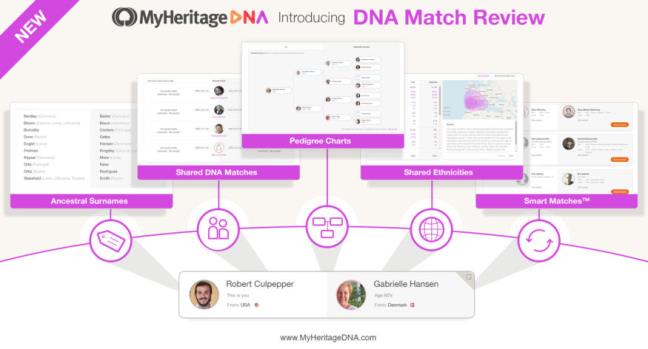
In the past, I’ve talked on this blog about several excellent (and still-evolving) tools on AncestryDNA, such as:
Competition in the DNA market space means that every company continues to add new and improved features to their site and testing experience. It’s worth checking back to explore what new information and tools might be available.
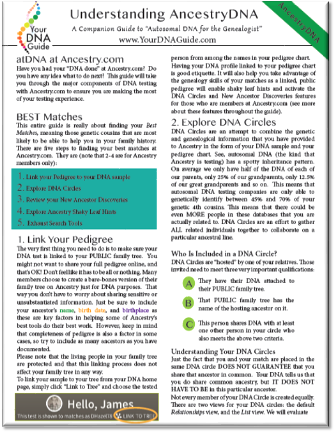 The Bottom Line
The Bottom Line
The bottom line here is that your testing company is always working to improve your DNA testing experience. So you should regularly return to your lists of DNA matches at the website of every company where you have tested. If you’re not sure how to use the site, please read some of my DNA posts on this blog and consult my quick reference DNA guides about these testing companies:
Keep checking back on those DNA matches. You never know what discovery might be just a click away.
Disclosure: This post contains affiliate links and Genealogy Gems will be compensated if you make a purchase after clicking on these links (at no additional cost to you). Thank you for supporting Genealogy Gems!
by Lisa Cooke | Nov 1, 2017 | 01 What's New, Heirloom, History, Memory Lane |
Flour sack dresses show how resourceful housewives of the past “made do” with whatever was at hand. But they weren’t the only clever ones–see how savvy flour and feed companies responded to their customers’ desires for cuter sacking.

The History of Flour Sack Dresses
During the tough economic times of the Great Depression, housewives needed new ways to produce what their families needed, including clothing. So they looked around the house–and even the barn–for extra fabric they could turn into dresses, aprons, or shirts.
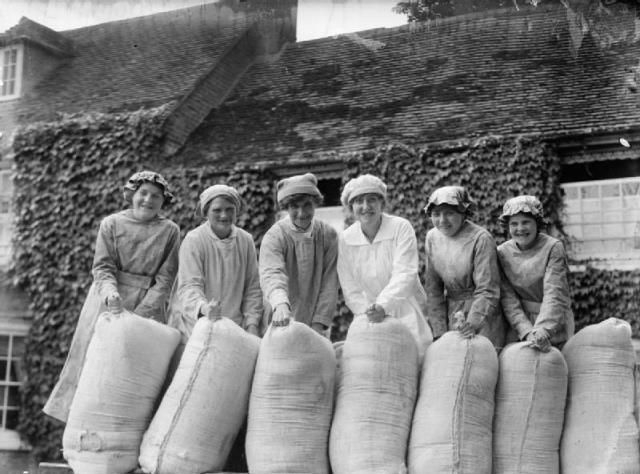
Female workers pose with sacks of flour in the grounds of a British mill during WWI. 1914. By Nicholls Horace [Public domain], via Wikimedia Commons. (Click to view.)
By the 1920s, these sacks had gotten a little cuter, some with gingham checked or striped patterns. So frugal housewives of the 1930s turned feed and flour sacks into everyday clothing for themselves and their families.
It didn’t take long for manufacturers of flour and feed to start printing their sacks with colors and patterns that women would want to buy. Some put patterns for dolls or stuffed animals on the bags. They even made it so you could wash out the ink so your new dress wouldn’t be a walking ad for Sunbonnet Sue flour! Newspapers and publishers also began printing patterns and ideas for getting the most out of the small yardage of a flour or feed sack.
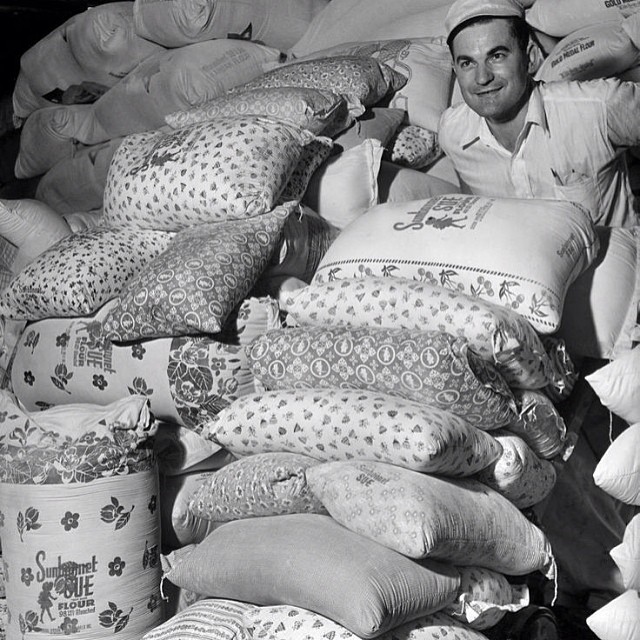
Old photo of printed fabric flour sacks or ‘feedsacks’. Flickr Creative Commons photo, uploaded by gina pina. Click to view.
A fascinating article at OldPhotoArchive.com shows some great images of flour and feed sack dresses. And the Smithsonian’s National Museum of American History has an online article about a feed sack dress from 1959, because these didn’t go out of fashion when the Great Depression ended! According to that article, World War II caused a cotton fabric shortage. Feed and flour sack dresses again became popular.

After the war, women continued to make these dresses, encouraged even further by national sewing contests. Women even sold off their extra flour or feed sacks to others who wanted them.
Memories of Flour Sack Dresses
A woman named Denise posted a neat memory at the end of the Smithsonian article. She says:
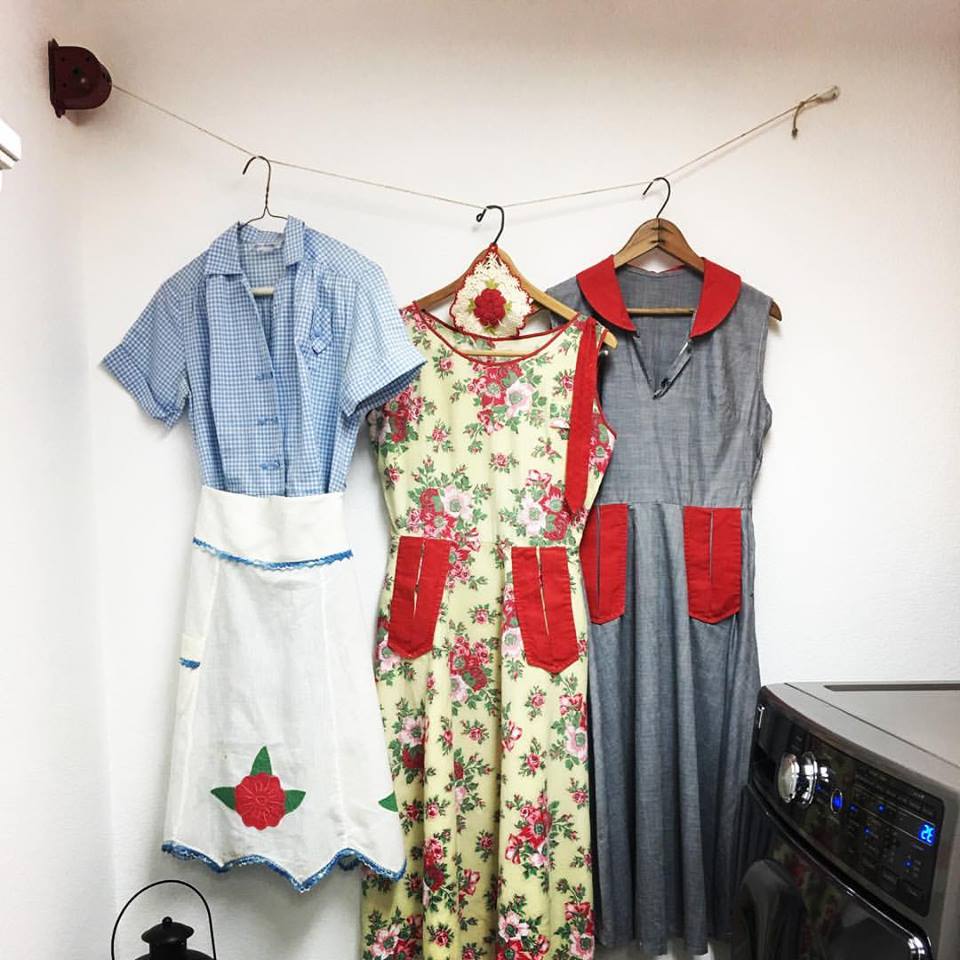
Click to view my Facebook post about my grandma’s 1940s house dresses.
“I was born in 1951. For the first four-five years of my life, all my dresses were sewn by my paternal grandmother from feed sacks. She would layer the fabric two to three layers deep and cut the main dresses from the same pattern. She would then add different details to each dress. Some sleeveless, some with little puffy fifties sleeves, some with self collars, some with contrasting solid collars. We lived in rural north GA, but nonetheless I was teased by my parents’ friends about my feed-sack dresses. Oh how I longed for store-bought dresses. Now, oh how I long to have some of those wonderful little feed sack dresses! They weren’t thought of as precious at all, so no one ever thought to keep them!”
I think a lot of people have fond—or at least vivid—memories of old dresses like these. I do! I posted a photo of my grandma’s old house dresses from the 1930s and 1940s on Instagram. What a response from everyone there and on Facebook! My grandma’s house dresses weren’t made from flour sacks, but they’re from the same era.
Want to see some eye-candy vintage fabrics or date your own family heirloom clothing? Check out these books:
Care for Your Flour Sack Dresses or Other Heirlooms
 Take better care of your own family heirloom pieces, whether they are photos, vintage fabrics, documents or other objects. Get Denise Levenick’s popular book How to Archive Family Keepsakes: Learn How to Preserve Family Photos, Memorabilia and Genealogy Records. This book will help you sort, identify, and preserve your own treasured family artifacts and memorabilia.
Take better care of your own family heirloom pieces, whether they are photos, vintage fabrics, documents or other objects. Get Denise Levenick’s popular book How to Archive Family Keepsakes: Learn How to Preserve Family Photos, Memorabilia and Genealogy Records. This book will help you sort, identify, and preserve your own treasured family artifacts and memorabilia.
Disclosure: This article contains affiliate links and Genealogy Gems will be compensated if you make a purchase after clicking on these links (at no additional cost to you). Thank you for supporting Genealogy Gems!
by Lisa Cooke | Sep 22, 2017 | 01 What's New, British, Military, Records & databases, Scottish Genealogy
Denmark Census Records are new at FamilySearch this week. Other new and updated genealogy records include new vital records for England, Catholic Parish records for Scotland, and various unique collections like WWII records for New Zealand, French Polynesian vital records, and military records and more for the United States.
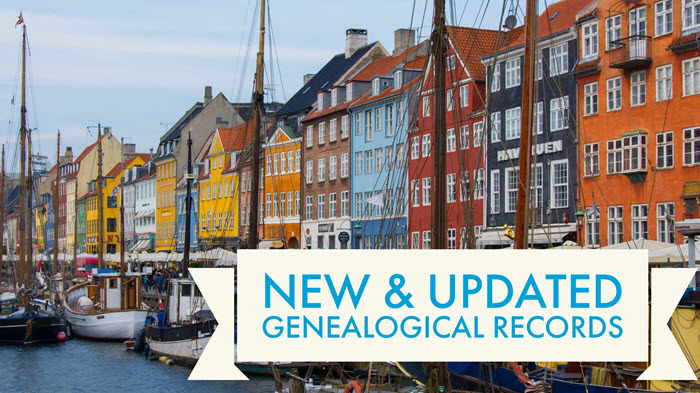
Denmark Census Records
FamilySearch.org now has Denmark Census collections for the following years: 1860, 1870, 1880, 1890, 1901, & 1906. These indexes (provided by MyHeritage) are totally free to explore at FamilySearch, and the images were provided previously from the National Archives of Denmark.
England Wills & Probate
New at Findmypast is an index of over 229,000 Lancashire Wills & Probate 1457-1858 records. This index of more than 229,000 records will give you details about the type of material available, the probate year, and your ancestor’s occupation and residence.
Also new from Findmypast this week are large records for Herefordshire. You can search indexes for Baptisms starting in the early 1500s, Marriages 1538-1936, Burials spanning four centuries, and Wills 1517-1700.
Scotland: Catholic Parish Records
An extensive collection of browsable Scottish Roman Catholic Parish records is now available at Findmypast. It consists of all eight Scottish dioceses: Aberdeen, Argyll & The Isles, Dunkeld, Galloway, Glasgow, Motherwell, St Andrews & Edinburgh, and Paisley. Records begin as early as 1736 and continue until 1942.
New Zealand WWII Records
The Auckland War Memorial Museum has made over 100,000 WWII records available free online. From a recent press release: “Of the 140,000 New Zealanders dispatched to serve overseas in WWII, 104,000 of them served with the 2NZEF. Auckland Museum is now making these WWII Army personnel records publicly accessible through Online Cenotaph.”
French Polynesia: Vital Records
New this week at FamilySearch: Civil registration of births, marriages, and deaths for French Polynesia, 1843-1999. Original records are located with the Tribunal Civil, Papeete, Tahiti.
United States Military Collections & More
Japanese internment camps. Now available at FamilySearch.org: War Relocation Authority Centers, Final Accountability Rosters, 1942-1946. From the collection description: “Digital images of originals are held by the National Archives at College Park, Maryland. These rosters are alphabetical lists of evacuees housed in relocation centers from 1945-1946. This project was completed in cooperation with Densho: The Japanese American Legacy Project.”
Audio recordings. Check out The Great 78 Project! You can listen to this collection of 78rpm records and cylinder recordings released in the early 20th century. These recordings were contributed to Internet Archive by users through the Open Source Audio collection. The Internet Archive has digitized many.
Montana. A new Birth Index 1870-1986 is available at Ancestry.com. The Death Index 1907-2015 has also been updated. These records come from the State of Montana Department of Public Health and Human Services. Copies of the actual certificates may be ordered from the Office of Vital Statistics.
Virginia. Also new at Ancestry.com are Virginia Vital Records, 1660-1923. Indexed information may include primary names and names of family members, as well as birth, marriage, death, and burial information. This collection was indexed by Ancestry World Archives Project contributors.
North Carolina. From the State Archives of North Carolina: New Veterans Oral History Collection Online. “The interviews, conducted since 2015 as audio interviews, are part of the Military Collection’s North Carolina Veterans Oral History Program, whose goal is to capture and provide access to the memories and experiences of the military servicemen and servicewomen from North Carolina, preserving them for the future scholarship.”

Be sure to share this post with your genealogy friends and groups so they can explore these wonderful new collections!
Disclosure: This post contains affiliate links and Genealogy Gems will be compensated if you make a purchase after clicking on these links (at no additional cost to you). Thank you for supporting Genealogy Gems!
by Lisa Cooke | Sep 15, 2017 | 01 What's New, Ancestry, Cemeteries, Records & databases |
If you’re looking for cemetery records, you’re in luck! This week there have been massive updates to Find A Grave’s global databases at Ancestry.com. But why search Find A Grave at Ancestry.com? We can think of 3 good reasons.
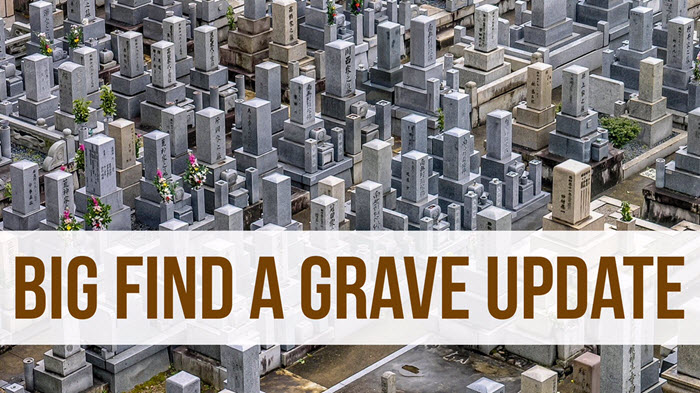
Find A Grave at Ancestry.com: Updated Collections

Did you know you can use Google Earth to find cemeteries? Click here to learn how.
The following Find A Grave collections have all been updated to Ancestry.com, where they can be linked directly to your tree:
You’ll also find these records updated at FamilySearch.com as well.
If there’s a specific grave you’re looking for, ask Find a Grave to help! Click here to learn how to submit a photo request to both Find a Grave and Billion Graves.
Why Use Find A Grave at Ancestry.com?
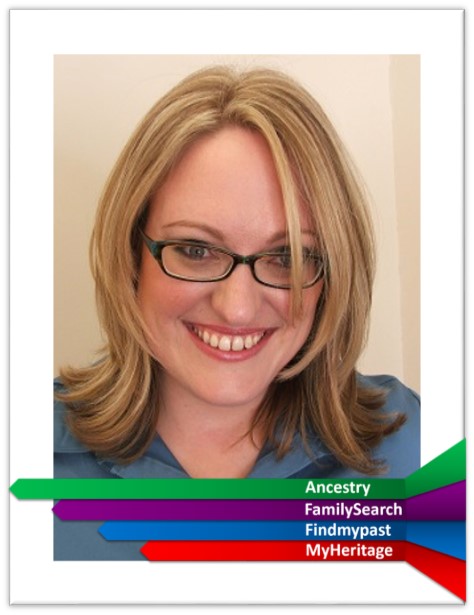
Sunny Morton, Genealogy Giants Guru
Find A Grave is a free website with crowd-sourced tombstone images and transcriptions from cemeteries all over the world. Last we checked, they boast 162 million grave records! Their catalog of cemeteries tops 400,000, spread out over 200 different countries, and they have at least a partial listing of graves for well over half of these (over 250,000).
So why would you go to Ancestry.com to search records that are already free at Find A Grave? Genealogy Gems Contributing Editor Sunny Morton, our resident expert on the giant genealogy websites, says:
“If you’re already an Ancestry.com subscriber, searching Find A Grave from within Ancestry.com may be a good choice for these three reasons:
1. One-stop searching. You’re already searching in Ancestry.com: you don’t need to remember to switch over to search Find A Grave separately for each ancestor.
2. Ancestry.com’s search tool. Find A Grave has a nice but basic search tool. It’s pickier about the search results it returns: does the spelling match? And is a potential result in the exact place you requested? (If you search a specific county, Find A Grave will only return results from that county–not in an adjacent county, across the state line, or even across the country where an ancestor may have been interred.) Lacey has a great example below.
From Lacey: Here’s a search of my 3X great grandfather at Find A Grave:
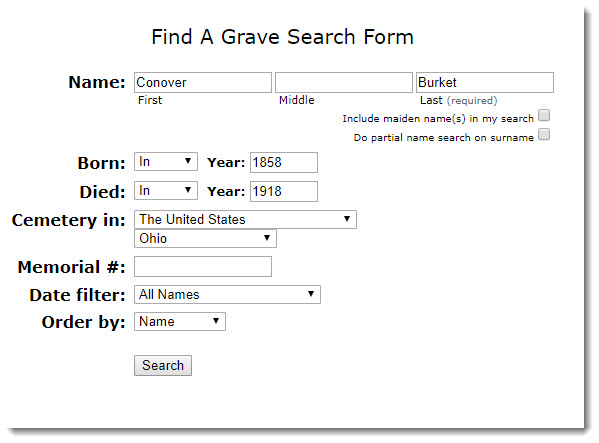
Unfortunately, no results:
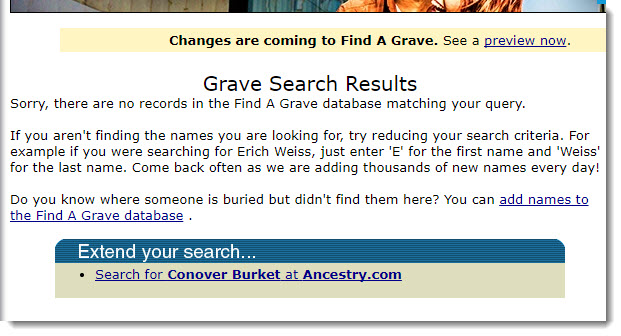
I then hopped over to Ancestry, went to the card catalog, and searched the U.S. Find A Grave Index:
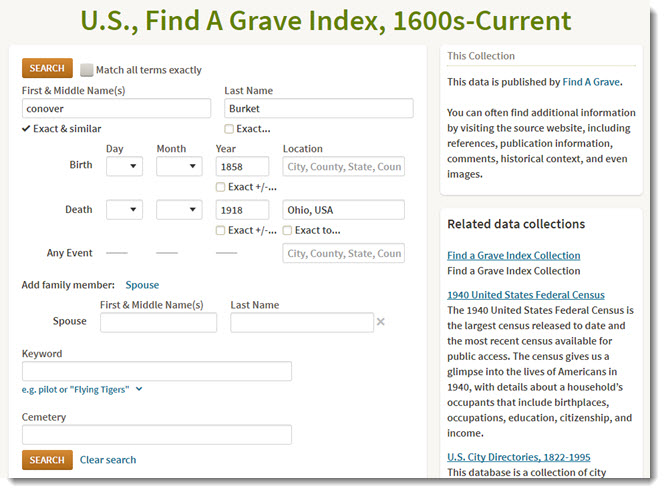
Turns out there was an extra “t” on his surname (see results below). I didn’t search on a partial name because I’ve never come across a different spelling of his before, and I certainly didn’t expect to see one on his tombstone! But sure enough, the name is not spelled as it had been throughout his life. It’s awfully nice that Ancestry could find it:
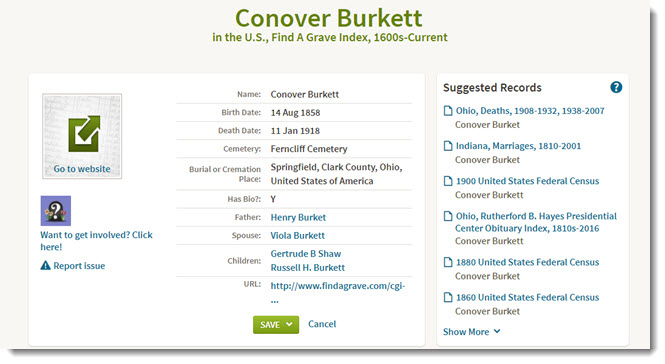
Ancestry.com is much more forgiving and flexible about spelling and places. It will return search result possibilities that don’t have to match exactly. As you can see from the screenshots above, Ancestry offers more fields to enter, including relatives’ names (and people are often buried with relatives), a more detailed place field, and keywords.
3. Tree-building ease. If you build your tree on Ancestry.com, it’s easy to attach Find A Grave search results to your ancestor’s tree profiles. If you search separately at Find A Grave, you have to create a separate source citation to attach to your tree.” (Note: hopefully, if you’re building your tree on Ancestry.com, you’re syncing it to your own software. RootsMagic and Family Tree Maker will both sync to your Ancestry tree–click here to see why Lisa Louise Cooke prefers RootsMagic.)
More Cemetery Resources
 Get detailed step-by-steps for using Find A Grave and Billion Graves, plus guides for understanding tombstone epitaphs and symbol meanings in this brand new book: The Family Tree Cemetery Field Guide. Discover tools for locating tombstones, tips for traipsing through cemeteries, an at-a-glance guide to frequently used gravestone icons, and practical strategies for on-the-ground research.Use coupon code GEMS17 for an extra 10% off! *Coupon valid through 12/31/17.
Get detailed step-by-steps for using Find A Grave and Billion Graves, plus guides for understanding tombstone epitaphs and symbol meanings in this brand new book: The Family Tree Cemetery Field Guide. Discover tools for locating tombstones, tips for traipsing through cemeteries, an at-a-glance guide to frequently used gravestone icons, and practical strategies for on-the-ground research.Use coupon code GEMS17 for an extra 10% off! *Coupon valid through 12/31/17.
https://test.lisalouisecooke.com/2016/07/cemetery-records/
Disclosure: This post contains affiliate links and Genealogy Gems will be compensated if you make a purchase after clicking on these links (at no additional cost to you). Thank you for supporting Genealogy Gems!
 Feedsack Secrets: Fashion from Hard Times
Feedsack Secrets: Fashion from Hard Times
 More and more people are flocking to these companies to have their own DNA tested. Why just this month, AncestryDNA announced they have tested 5 million people. It was only in January of 2017 that they announced they’d hit 3 million, so they’ve added more than two million people so far this year.
More and more people are flocking to these companies to have their own DNA tested. Why just this month, AncestryDNA announced they have tested 5 million people. It was only in January of 2017 that they announced they’d hit 3 million, so they’ve added more than two million people so far this year.

 While you’ve been busy recently tracking down census records and virtually visiting the courthouses, your DNA testing companies have been busily adding to their offerings. Just recently, MyHeritage revealed a beautiful, streamlined way to review each of your DNA matches. (Remember, it’s free to upload your DNA there. Click here to see how. You can also purchase a test from MyHeritageDNA.)
While you’ve been busy recently tracking down census records and virtually visiting the courthouses, your DNA testing companies have been busily adding to their offerings. Just recently, MyHeritage revealed a beautiful, streamlined way to review each of your DNA matches. (Remember, it’s free to upload your DNA there. Click here to see how. You can also purchase a test from MyHeritageDNA.)
 The Bottom Line
The Bottom Line


















